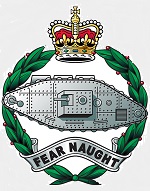Dragon DRR63246 British Sherman Firefly Mk. Vc Medium Tank - 4th/7th Royal Dragoon Guard, 8th Armoured Brigade, France, 1944 (1:72 Scale)
"Quis Separabit (Who shall separate us)"
- Motto of the 4th/7th Royal Dragoon Guard
 The Sherman Firefly was a medium tank used by the United Kingdom and some armoured formations of other Allies in the Second World War. It was based on the US M4 Sherman but was fitted with the more powerful British 76.2 mm (3.00 in) calibre 17-pounder anti-tank gun as its main weapon. Conceived as a stopgap until future British tank designs came into service, the Sherman Firefly became the most common vehicle mounting the 17-pounder in the war.
The Sherman Firefly was a medium tank used by the United Kingdom and some armoured formations of other Allies in the Second World War. It was based on the US M4 Sherman but was fitted with the more powerful British 76.2 mm (3.00 in) calibre 17-pounder anti-tank gun as its main weapon. Conceived as a stopgap until future British tank designs came into service, the Sherman Firefly became the most common vehicle mounting the 17-pounder in the war.
The British Army made extensive use of Sherman tanks, but they expected to have their own tank models developed soon, so the idea of mounting the 17-pounder in the Sherman was initially rejected. However, through the efforts of two persistent British officers, government reluctance was eventually overcome, and the Firefly went into production. This proved fortunate, as the Cruiser Mk VIII Challenger and Cruiser Mk VIII Cromwell tank designs experienced difficulties and delays.
After the problem of getting such a large gun to fit in the Sherman's turret was solved, the Firefly was put into production in early 1944, in time to equip the 21st Army Group, commanded by General Bernard Montgomery, for the Normandy landings. It soon became highly valued, as its gun could almost always penetrate the armour of the Panther and Tiger tanks it faced in Normandy, something no other British or US tank could reliably do. Because the Firefly's barrel was visibly longer than that of a normal 75 mm Sherman, crews tried to countershade camouflage it so the tank would look like a regular Sherman from a distance. Between 2,100 and 2,200 were manufactured before production ended in 1945, it is unknown if this includes 100 tanks built for the United States.
Pictured here is a 1:72 Firefly Mk. Vc tank that was attached to the 4th/7th Royal Dragoon Guard, 8th Armoured Brigade, then deployed to France during 1944.
Now in stock!
Dimensions:
Length: 3-1/4-inches
Width: 1-1/2-inches
Release Date: July 2024
Historical Account: "Dragoon Guards" - In 1939, equipped with Vickers Mk.VI light tanks, 4th/7th Royal Dragoon Guard deployed to France with the British Expeditionary Force (BEF), as the reconnaissance regiment of the 2nd Infantry Division under I Corps. It participated in the Battle of France, fighting in northern France and Belgium, and evacuated from Dunkirk in Operation Dynamo. The personnel of the regiment landed in England on June 3rd, 1940, having abandoned their vehicles.
After re-equipping with Beaverette armored cars, the regiment was posted to the 1st Armoured Reconnaissance Brigade and then, in December 1940, to the 27th Armoured Brigade, part of the 9th Armoured Division, equipped with Covenanter tanks. At this time, a small group of personnel was detached to form the cadre of a new regiment, the 22nd Dragoons. In 1943, the regiment joined the 79th Armoured Division, equipping with amphibious Valentine tanks, and later re-equipping with M4 Sherman DD tanks.
Under command of the 8th Armoured Brigade, the regiment landed on King Green, Gold Beach, at 07:20 on June 6th, 1944, as part of the D-Day landings, supporting the 50th (Northumbrian) Infantry Division. The regiment later participated in the Battle for the Falaise Gap, and as part of the armored forces in Operation Market Garden - the regiment pushing as far as Driel, on the south bank of the Rhine a couple of miles from Arnhem. Among other notable achievements, it was the first armoured unit to cross the Seine.






![US M4A3 Sherman Medium Tank with 3 Figures - Unidentified Unit, Normandy, 1944 [D-Day Commemorative Packaging] (1:16 Scale)](http://cdn4.volusion.store/qh9e9-jdqv9/v/vspfiles/photos/UNI85007-1.jpg?v-cache=1740197136)

![Star Trek Bajoran Transport [With Collector Magazine]](http://cdn4.volusion.store/qh9e9-jdqv9/v/vspfiles/photos/EMST0083-1.jpg?v-cache=1740197136)
